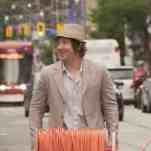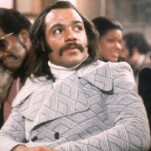Top Chef, "Holiday Special"
Nothing says Christmas dinner in my house like quince and bacon! Actually, the holidays are all about food and one-upmanship, so a one-off cooking competition for the season isn't all that far-fetched. A mixed bag of colorful contestants from seasons one through three arrive in Chicago with their knives in tow, from the sacrificial lambs (Josie and Sandee) to the ringers (Marcel and Stephen) to the top tier (C.J. and Tiffani). $20,000 is on the line, and although the show keeps cutting to them talking about how much they need the money (and I'm sure they do), I think this group was chosen for their competitive personalities. I feel confident that it was never about the money for Trey, who looks like he should be upending wide receivers and signing them with a Sharpie.
The quickfire confronts the chefs with a game of Dirty Santa: pick a mystery ingredient out of the gift pile, but risk having it stolen by the people who pick after you. Santa, in this case, is Le Bernardin chef Eric Ripert, who poses awkwardly during the obligatory montage of chefs fawning over him in their confessionals, his elegant French head sticking out of a Santa suit with a pillow down the front.
While Marcel plans to "pursue excellence basically" with his tuna dish, Stephen deliberately steals the ingredient I'd avoid at all costs: yams. It's probably the legacy of many cafeteria steam tables of orange glop covered with marshmallow goo, but even at its best, I can't think of anything I'd less like to put in my mouth than a yam and lavender soup. Ripert agrees, apologetically noting that lavender "has the tendency to taste like a soap bar." Most of the drama comes from Josie's unsuccessful search for a can opener for her truffles, leading to an embarrassing sequence where she gingerly perforates the lid with the heel of her knife. Whack the top off and get on with your life, Josie. In the end, she doesn't manage to get any truffles out or any sauce on her scallops.
C.J. wins limited immunity in the elimination challenge, which is a three-course holiday meal with two chefs axed after each course, leaving two chefs standing at the end. (If you can see what's coming with two contestants still in the running after the meal, why couldn't the chefs?) This was one of the better conceived challenges in Top Chef history, I must say. Usually when the chefs are given plenty of money, ample time, and no gimmicky restrictions, they respond by making safe food rather than pulling out all the stops. But the caliber of the competition and the interesting strategy required by the escalating pressure of the course structure produced cuisine that was as innovative as it was luxurious.
The meal is served family style, the serving dishes handed around the table of four judges and five guest judges from seasons past. (Marcel's deer-in-the-headlights stare upon being confronted with this panel of culinary celebrities belied his usual arrogance.) Somewhat surprisingly, Stephen is eliminated after one course (gnocchi, often a landmine for would-be Top Chefs), along with Sandee and her watery mushroom soup.
And then the real challenge of the meal emerges: during the perhaps 10 minutes that the chefs are down in the dining room delivering and explaining their dishes, their next courses are sitting in the oven ticking past their expiry dates. Betty explains the problem with a maxim for the ages — "you can't uncook lamb" — and then goes home along with Josie and her overdone turkey.
Marcel seemed to get a free pass on talent alone (or maybe his probably-second-place quickfire entry) to get to the third round; his "weird" chicken liver cakes were much maligned in course 2, but he survived to produce a gastrique (at last) in course 3. Alas, his unappetizing gray lamb pales next to Trey's, and he and C.J. are out.








































